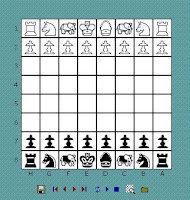
- Shah (king) moves as in std chess
- Rukh (rook) moves as in std chess
- Faras (knight) moves as in std chess
- Baidaq (pawn) moves as in std chess
- Firzan (queen) moves to the first diagonal square
- Alfil (elephant, bishop) leaps to the second diagonal square, never occupying the first diagonal
The rules of Shatranj are similar to Standard Chess, with the following exceptions:
There is no initial two-step Pawn move
- There is no en passant capture option
- There is no castling option
- Pawns arriving at the last rank always promote to Firzans
- Stalemate counts as a win
- Bare King counts as a win, provided that your King cannot be bared on the very next move
- Two bare Kings count as a draw
The first major adjustment I made in the game was in the way I treated the Firzan, or the equivalent of the Queen. Here, the Firzans are not as powerful as they are in modern chess. Moving only to the next diagonal squares around it, you can actually consider it as some sort of a bodyguard for the Shah. Which is quite logical and reasonable if you consider the way of the courts of the kingdoms of the world, where the "general" doesn't exactly go to the ends of the earth and leaves his sovereign.
The second thing to consider is the pace of the game. It's a whole new game if your Alfil has to take three moves to get to the other side of the board, rather than the sweeping motion it can normally do in chess. That, plus the restrained movement of the Firzan, and you have a much slower game, that unfolds more gradually. In my opinion, this game also requires more strategizing, rather than a "bring down the wall" type of chess that we often see.
It's also an influence on me to play on Schemingmind's piece set for Shatranj, as featured above. They succeeded in retaining the feeling of an "ancient" game. I can't help but feel and imagine those Persian folks dressed in their traditional garments, pushing rock sculptures of their digital counterparts that I click and drag.
I would have wanted to post my recent Shatranj game here, but I was thinking that chess publishers would probably render the Alfils and some other pieces in modern chess equivalent. Best that you head over to Schemingmind and try it yourself, as well as the rest that the site has to offer.
Know more about Variants! Click HERE!




5 comments:
i
wonder:
what really is
"bring down the wall" type of chess...
What I meant by "bring down the wall" was the incessant way attacks can be staged in the standard chess game. Because of the distance that can be covered by all major pieces, you can get attacked from as far back as the other side of the board by a number of pieces in succession. Such a scenario is minimized in Shatranj, since the only major piece that can reach so many squares in one move is Rukh (rook). If you want to get a feel of it, you can try to view my latest game here:
http://www.schemingmind.com/game.aspx?game_id=168513
The site may require you to sign in first, but you can do so by signing in as "guest" in both username and password. Then proceed to check out the game by pasting the link to your address bar.
In my opinion, the way the game progressed was much slower, due to the limited movements of most of the pieces. The attacks are also coming in mostly from short-range pieces.
Hope that helped... and I wish I could have tracked back to you. I hope you are a regular here on my blog, though
I too like the slowness of the game, which makes it less abstract and also less prone to silly mistakes because of rampaging bishops appearing from nowhere. However, I much prefer Makruk, which is theoretically very similar. The Kuhns (silver generals) provide a lot more potential than the unwieldly elephants. I still don't know if I like the draw rules, but that's probably mostly because they are not enforced on SchemingMind. I'd be happy to play either if you ever fancy a game on SM: my username is same as given here.
thanks for dropping by, I will definitely have a game with you. on my way to check SM now :)
I've always been interested in shatranj for its variants. Have you ever played any of the variants of shatranj?
"Joe Shatranj"
Post a Comment